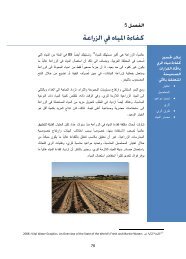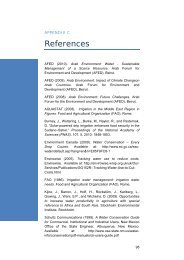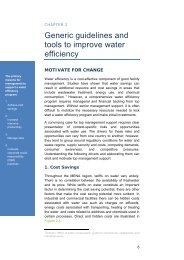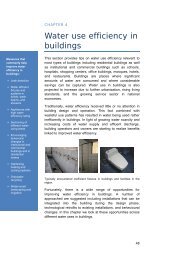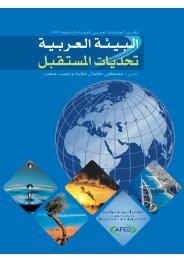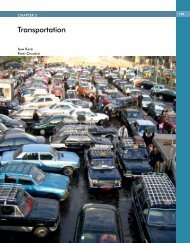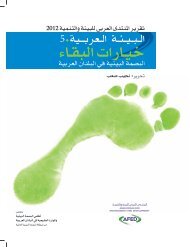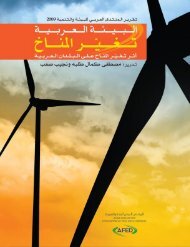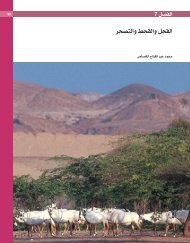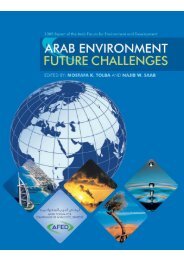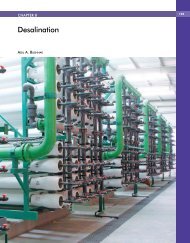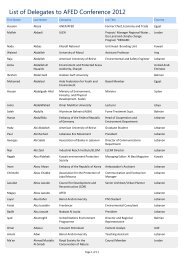Impact of Climate Change on Arab Countries - (IPCC) - Working ...
Impact of Climate Change on Arab Countries - (IPCC) - Working ...
Impact of Climate Change on Arab Countries - (IPCC) - Working ...
You also want an ePaper? Increase the reach of your titles
YUMPU automatically turns print PDFs into web optimized ePapers that Google loves.
ARAB ENVIRONMENT: CLIMATE CHANGE 23<br />
Lighting accounts for nearly 23% <str<strong>on</strong>g>of</str<strong>on</strong>g> the total<br />
electricity c<strong>on</strong>sumpti<strong>on</strong> in Egypt, half <str<strong>on</strong>g>of</str<strong>on</strong>g> which is<br />
c<strong>on</strong>sumed in the residential and commercial sectors.<br />
The GEF/UNDP supported “Energy<br />
Efficiency Improvement & Greenhouse Gas<br />
Reducti<strong>on</strong> Project” has undertaken some initiatives<br />
to promote CFLs. These include a study to<br />
reduce the custom duties <strong>on</strong> CFLs from 30% to<br />
5% in order to help cut their initial cost, implement<br />
a lease program <str<strong>on</strong>g>of</str<strong>on</strong>g> CFLs by the state-owned<br />
electricity distributi<strong>on</strong> companies, and encourage<br />
local manufacturing <str<strong>on</strong>g>of</str<strong>on</strong>g> CFLs. There is no available<br />
informati<strong>on</strong> <strong>on</strong> government’s incentives<br />
used to encourage local manufacturers; however,<br />
six local manufacturing plants were established.<br />
These activities, together with public educati<strong>on</strong><br />
and marketing campaigns have led to increase the<br />
market size <str<strong>on</strong>g>of</str<strong>on</strong>g> CFL in Egypt to 4.4 milli<strong>on</strong> in<br />
2007. It was estimated that the accumulated<br />
CO 2 reducti<strong>on</strong> due to those activities up till<br />
2007 was nearly 2.3 milli<strong>on</strong> t<strong>on</strong>s (GEF/UNDP,<br />
2008).<br />
In Tunisia, several projects to disseminate about<br />
10 milli<strong>on</strong> CFLs during the period 2007-2011<br />
are planned under the Clean Development<br />
Mechanism (CDM) <str<strong>on</strong>g>of</str<strong>on</strong>g> the Kyoto Protocol.<br />
These projects are still under development.<br />
According to the ANME, nearly <strong>on</strong>e milli<strong>on</strong> t<strong>on</strong>s<br />
<str<strong>on</strong>g>of</str<strong>on</strong>g> CO 2 reducti<strong>on</strong> is projected up to 2012<br />
(ANME, 2008).<br />
Fuel switching<br />
Worldwide, natural gas c<strong>on</strong>tributed about 17%<br />
<str<strong>on</strong>g>of</str<strong>on</strong>g> the total fuels for electricity generati<strong>on</strong> in<br />
2007. It is projected that natural gas will play an<br />
important role in the transiti<strong>on</strong> to low-carb<strong>on</strong><br />
energy in the near future. This is because it produces<br />
less carb<strong>on</strong> dioxide per unit <str<strong>on</strong>g>of</str<strong>on</strong>g> energy than<br />
oil and coal do. Statistics show that the world’s<br />
c<strong>on</strong>sumpti<strong>on</strong> <str<strong>on</strong>g>of</str<strong>on</strong>g> natural gas has been expanding<br />
during the last decade. The same trend was seen<br />
in the <strong>Arab</strong> regi<strong>on</strong>. Switching to natural gas has<br />
been a crucial resp<strong>on</strong>se to many factors including<br />
mitigati<strong>on</strong> <str<strong>on</strong>g>of</str<strong>on</strong>g> air polluti<strong>on</strong> and GHG emissi<strong>on</strong>s.<br />
The critical role natural gas is playing and is<br />
expected to play in the global energy market was<br />
emphasized with the recent establishment <str<strong>on</strong>g>of</str<strong>on</strong>g> the<br />
“Gas Exporting <strong>Countries</strong> Forum (GECF)” in<br />
2008, which is hosted in Doha, Qatar. Leading<br />
<strong>Arab</strong> gas producers, namely Algeria, Egypt, UAE,<br />
Qatar, and Libya, have joined the forum.<br />
Natural gas represents the sec<strong>on</strong>d largest primary<br />
energy resource used in the <strong>Arab</strong> countries<br />
at nearly 23% <str<strong>on</strong>g>of</str<strong>on</strong>g> the final energy c<strong>on</strong>sumpti<strong>on</strong><br />
in 2006. Twelve <strong>Arab</strong> countries are currently<br />
using natural gas, in some form, in power generati<strong>on</strong>,<br />
industry, the residential and commercial<br />
sectors, and the transport sector. <strong>Arab</strong> gas<br />
reserves represent nearly 30% <str<strong>on</strong>g>of</str<strong>on</strong>g> global reserves.<br />
Total gas producti<strong>on</strong> in the <strong>Arab</strong> countries<br />
accounts for about 12.5% <str<strong>on</strong>g>of</str<strong>on</strong>g> the global gas producti<strong>on</strong><br />
(LAS, 2007). Two regi<strong>on</strong>al gas projects<br />
are underway aiming to increase natural gas utilizati<strong>on</strong><br />
in the <strong>Arab</strong> regi<strong>on</strong>. The first project,<br />
named the <strong>Arab</strong> gas pipeline, aims to c<strong>on</strong>nect<br />
the Egyptian gas network to Jordan, Syria, and<br />
then to Turkey with a total length <str<strong>on</strong>g>of</str<strong>on</strong>g> 1200 km.<br />
The sec<strong>on</strong>d regi<strong>on</strong>al project named “Dolphin”<br />
will transport Qatari gas to the UAE with a total<br />
length <str<strong>on</strong>g>of</str<strong>on</strong>g> 370 km. Some other regi<strong>on</strong>al gas projects<br />
are planned such as a project between<br />
North African <strong>Arab</strong> countries, and between<br />
them and Europe.<br />
In power generati<strong>on</strong>, the switch from petroleum<br />
products to natural gas was the most comm<strong>on</strong>ly<br />
reported activity. For example, the use <str<strong>on</strong>g>of</str<strong>on</strong>g> natural<br />
gas was increased c<strong>on</strong>siderably in a number <str<strong>on</strong>g>of</str<strong>on</strong>g><br />
countries. In Tunisia, most <str<strong>on</strong>g>of</str<strong>on</strong>g> the thermally generated<br />
energy supply comes from natural gas.<br />
This has avoided 900,000 t CO 2 emissi<strong>on</strong>s per<br />
annum, relative to a scenario in which oil-based<br />
products were used instead. Natural gas is also<br />
playing a key role in Egypt’s energy policy. Given<br />
its ec<strong>on</strong>omic and envir<strong>on</strong>mental advantages, natural<br />
gas will improve the overall energy efficiency<br />
and envir<strong>on</strong>mental quality <str<strong>on</strong>g>of</str<strong>on</strong>g> Egypt. Switching<br />
from oil to gas was identified as a priority measure<br />
in the Nati<strong>on</strong>al Acti<strong>on</strong> Plan <strong>on</strong> <str<strong>on</strong>g>Climate</str<strong>on</strong>g><br />
<str<strong>on</strong>g>Change</str<strong>on</strong>g> that was prepared by the Egyptian<br />
Envir<strong>on</strong>mental Affairs Agency in 1999. The<br />
energy policy <str<strong>on</strong>g>of</str<strong>on</strong>g> Egypt has been developed to<br />
promote the substituti<strong>on</strong> <str<strong>on</strong>g>of</str<strong>on</strong>g> natural gas in various<br />
sectors. Strategies include: (i) developing gas<br />
infrastructure to expand gas markets and develop<br />
domestic gas demand – the market share <str<strong>on</strong>g>of</str<strong>on</strong>g> natural<br />
gas in the total hydrocarb<strong>on</strong> c<strong>on</strong>sumpti<strong>on</strong><br />
has increased to about 45%; (ii) the substituti<strong>on</strong><br />
<str<strong>on</strong>g>of</str<strong>on</strong>g> heavy fuel oil with natural gas in electricity<br />
generati<strong>on</strong> has made c<strong>on</strong>siderable reducti<strong>on</strong>s in<br />
air polluti<strong>on</strong>; (iii) promoti<strong>on</strong> <str<strong>on</strong>g>of</str<strong>on</strong>g> Compressed<br />
Natural Gas (CNG) as a transport fuel is also<br />
underway; and (iv) encouraging private sector<br />
investments in the gas industry. A number <str<strong>on</strong>g>of</str<strong>on</strong>g> pri-



